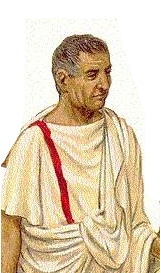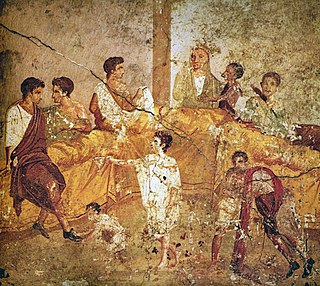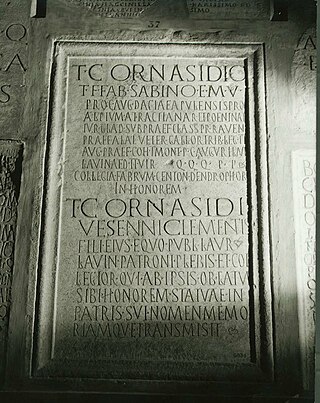
In ancient Rome, an angusticlavia, angusticlavus or angustus clavus was a narrow-strip tunic (tunica) with two narrow vertical Tyrian purple stripes (clavi). The tunic was typically worn under the toga with the right side stripe visible. [1]

In ancient Rome, an angusticlavia, angusticlavus or angustus clavus was a narrow-strip tunic (tunica) with two narrow vertical Tyrian purple stripes (clavi). The tunic was typically worn under the toga with the right side stripe visible. [1]
The angusticlavia was the tunic associated with the rank and office of the eques , or equestrians, one of the two highest legal orders in aristocratic Rome. Order members were military men, often patricians (patrici), who served as the cavalry units in war. During times of peace they frequently served as personal assistants to Roman senators. Equestrians wore the angusticlavia under the trabea , a short toga of distinctive form and color. They also wore equestrian shoes ( calcei ), and a gold ring ( anulus aureus ). The tunic's stripes were about an inch wide, which contrasted with the senator's laticlavus , which bore three-inch wide stripes. [2] [3]
The angusticlavia's purple-hued bands distinguished members of the equestrian order from other Roman dignitaries and from regular citizens. In ancient Rome, the color purple became increasingly linked to the higher classes, and eventually to the emperor and the empire's magistrates. Thus, the angusticlavia served to indicate social status above regular citizenry but below senators and magistrates. [4] [5] [6] [7]
On certain occasions, particularly during times of political or social upheaval, senators in Rome chose to wear the equestrian tunic as a public display of distress. This practice was part of the semi-egalitarian legacy of the Republic. In 58 BCE, when the tribune of the plebs Clodius was pushing Cicero into exile, the senators took on the angusticlavia in public protest. In 53 BCE, during a period of civic violence, the consuls put aside their senatorial dress (the laticlavus) and summoned the Senate in equestrian attire (the angusticlavia). [8] Over the course of ancient Roman history, the angusticlavia lost its symbolic meaning and class association. Wall paintings and other representations of the Roman past "show all types of men and boys wearing stripes of similar width – but there were later attempts to enforce or reintroduce the senatorial and equestrian classes". [9]
The Latin word angusticlavia is compounded of angustus ("narrow; small") and clavus ("nail; stud"). [10] The word clavus, or "nail", refers to the stripes, for being as long as nails. The term angustus, or "narrow", refers to these stripes or ornaments as being slimmer than on the senatorial laticlavus. [11]

The cursus honorum was the sequential order of public offices held by aspiring politicians in the Roman Republic and the early Roman Empire. It was designed for men of senatorial rank. The cursus honorum comprised a mixture of military and political administration posts; the ultimate prize for winning election to each "rung" in the sequence was to become one of the two consuls in a given year.

The Roman Republic was the era of classical Roman civilization beginning with the overthrow of the Roman Kingdom and ending in 27 BC with the establishment of the Roman Empire. During this period, Rome's control expanded from the city's immediate surroundings to hegemony over the entire Mediterranean world.

The Roman triumph was a civil ceremony and religious rite of ancient Rome, held to publicly celebrate and sanctify the success of a military commander who had led Roman forces to victory in the service of the state or, in some historical traditions, one who had successfully completed a foreign war.

The toga, a distinctive garment of ancient Rome, was a roughly semicircular cloth, between 12 and 20 feet in length, draped over the shoulders and around the body. It was usually woven from white wool, and was worn over a tunic. In Roman historical tradition, it is said to have been the favored dress of Romulus, Rome's founder; it was also thought to have originally been worn by both sexes, and by the citizen-military. As Roman women gradually adopted the stola, the toga was recognized as formal wear for male Roman citizens. Women found guilty of adultery and women engaged in prostitution might have provided the main exceptions to this rule.

The stola was the traditional garment of Roman women, corresponding to the toga that was worn by men. It was also called vestis longa in Latin literary sources, pointing to its length.

The culture of ancient Rome existed throughout the almost 1,200-year history of the civilization of Ancient Rome. The term refers to the culture of the Roman Republic, later the Roman Empire, which at its peak covered an area from present-day Lowland Scotland and Morocco to the Euphrates.
The equites constituted the second of the property-based classes of ancient Rome, ranking below the senatorial class. A member of the equestrian order was known as an eques.

A tunic is a garment for the body, usually simple in style, reaching from the shoulders to a length somewhere between the hips and the knees. The name derives from the Latin tunica, the basic garment worn by both men and women in Ancient Rome, which in turn was based on earlier Greek garments that covered wearers' waists.
A military tribune was an officer of the Roman army who ranked below the legate and above the centurion. Young men of Equestrian rank often served as military tribune as a stepping stone to the Senate. The tribunus militum should not be confused with the elected political office of tribune of the people (tribunus plebis) nor with that of tribunus militum consulari potestate.
Clavus may refer to:
In ancient Roman regalia, a laticlave or clavus was a broad stripe or band of purple on the fore part of the tunic, worn by senators as an emblem of office. The name laticlavia translates to "broad nail" and figuratively "broad stripe", in contrast to the "narrow stripe" (angusticlavia) which appeared on the tunics of lower social ranks.
Marcus Livius Drusus was a Roman politician and reformer. He is most famous for his legislative programme during his term as tribune of the plebs in 91 BC. During his year in office, Drusus proposed wide-ranging legislative reforms, including offering citizenship to Rome's Italian allies.

Clothing in ancient Rome generally comprised a short-sleeved or sleeveless, knee-length tunic for men and boys, and a longer, usually sleeved tunic for women and girls. On formal occasions, adult male citizens could wear a woolen toga, draped over their tunic, and married citizen women wore a woolen mantle, known as a palla, over a stola, a simple, long-sleeved, voluminous garment that modestly hung to cover the feet. Clothing, footwear and accoutrements identified gender, status, rank and social class. This was especially apparent in the distinctive, privileged official dress of magistrates, priesthoods and the military.

The preservation of fabric fibers and leathers allows for insights into the attire of ancient societies. The clothing used in the ancient world reflects the technologies that these peoples mastered. In many cultures, clothing indicated the social status of various members of society.

The Roman Senate was the highest and constituting assembly of ancient Rome and its aristocracy. With different powers throughout its existence it lasted from the first days of the city of Rome as the Senate of the Roman Kingdom, to the Senate of the Roman Republic and Senate of the Roman Empire and eventually the Byzantine Senate of the Eastern Roman Empire, existing well into the post-classical era and Middle Ages.

The Senate of the Roman Empire was a political institution in the ancient Roman Empire. After the fall of the Roman Republic, the constitutional balance of power shifted from the Roman Senate to the Roman Emperor. Beginning with the first emperor, Augustus, the Emperor and the Senate were technically two co-equal branches of government. In practice, however, the actual authority of the imperial Senate was negligible, as the Emperor held the true power of the state. As such, membership in the senate became sought after by individuals seeking prestige and social standing, rather than actual authority. During the reigns of the first Emperors, legislative, judicial, and electoral powers were all transferred from the "Roman assemblies" to the Senate. However, since the control that the Emperor held over the senate was absolute, the Senate acted as a vehicle through which the Emperor exercised his autocratic powers.

A tribunus angusticlavius was a senior military officer in the Roman legions during the late Roman Republic and the Principate.

The tres militiae was a career progression of the Roman Imperial army for men of the equestrian order. It developed as an alternative to the cursus honorum of the senatorial order for enabling the social mobility of equestrians and identifying those with the aptitude for administration. The three posts, typically held over a period of two to four years, were Praefectus cohortis, Tribunus angusticlavius, and Praefectus alae.

The clothing of the people in biblical times was made from wool, linen, animal skins, and perhaps silk. Most events in the Hebrew Bible and New Testament take place in ancient Israel, and thus most biblical clothing is ancient Hebrew clothing. They wore underwear and cloth skirts.

The calceus was the common upper-class male footwear of the Roman Republic and Empire. Normally made of leather and hobnailed, it was flat soled and typically reached the lower shin, entirely covering the foot and ankle. It was secured with crossed thongs or laces. Equivalent to a short boot or high-top shoe, it was lighter than the military caliga but sturdier than slip-on shoes like the soccus and able to easily handle outdoor use.